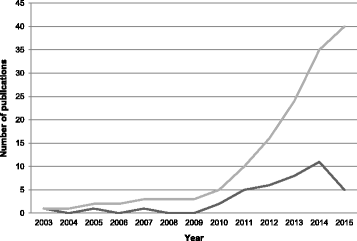What is an evidence map? A systematic review of published evidence maps and their definitions, methods, and products
- PMID: 26864942
- PMCID: PMC4750281
- DOI: 10.1186/s13643-016-0204-x
What is an evidence map? A systematic review of published evidence maps and their definitions, methods, and products
Abstract
Background: The need for systematic methods for reviewing evidence is continuously increasing. Evidence mapping is one emerging method. There are no authoritative recommendations for what constitutes an evidence map or what methods should be used, and anecdotal evidence suggests heterogeneity in both. Our objectives are to identify published evidence maps and to compare and contrast the presented definitions of evidence mapping, the domains used to classify data in evidence maps, and the form the evidence map takes.
Methods: We conducted a systematic review of publications that presented results with a process termed "evidence mapping" or included a figure called an "evidence map." We identified publications from searches of ten databases through 8/21/2015, reference mining, and consulting topic experts. We abstracted the research question, the unit of analysis, the search methods and search period covered, and the country of origin. Data were narratively synthesized.
Results: Thirty-nine publications met inclusion criteria. Published evidence maps varied in their definition and the form of the evidence map. Of the 31 definitions provided, 67 % described the purpose as identification of gaps and 58 % referenced a stakeholder engagement process or user-friendly product. All evidence maps explicitly used a systematic approach to evidence synthesis. Twenty-six publications referred to a figure or table explicitly called an "evidence map," eight referred to an online database as the evidence map, and five stated they used a mapping methodology but did not present a visual depiction of the evidence.
Conclusions: The principal conclusion of our evaluation of studies that call themselves "evidence maps" is that the implied definition of what constitutes an evidence map is a systematic search of a broad field to identify gaps in knowledge and/or future research needs that presents results in a user-friendly format, often a visual figure or graph, or a searchable database. Foundational work is needed to better standardize the methods and products of an evidence map so that researchers and policymakers will know what to expect of this new type of evidence review.
Systematic review registration: Although an a priori protocol was developed, no registration was completed; this review did not fit the PROSPERO format.
Figures



References
Publication types
MeSH terms
LinkOut - more resources
Full Text Sources
Other Literature Sources
Miscellaneous

